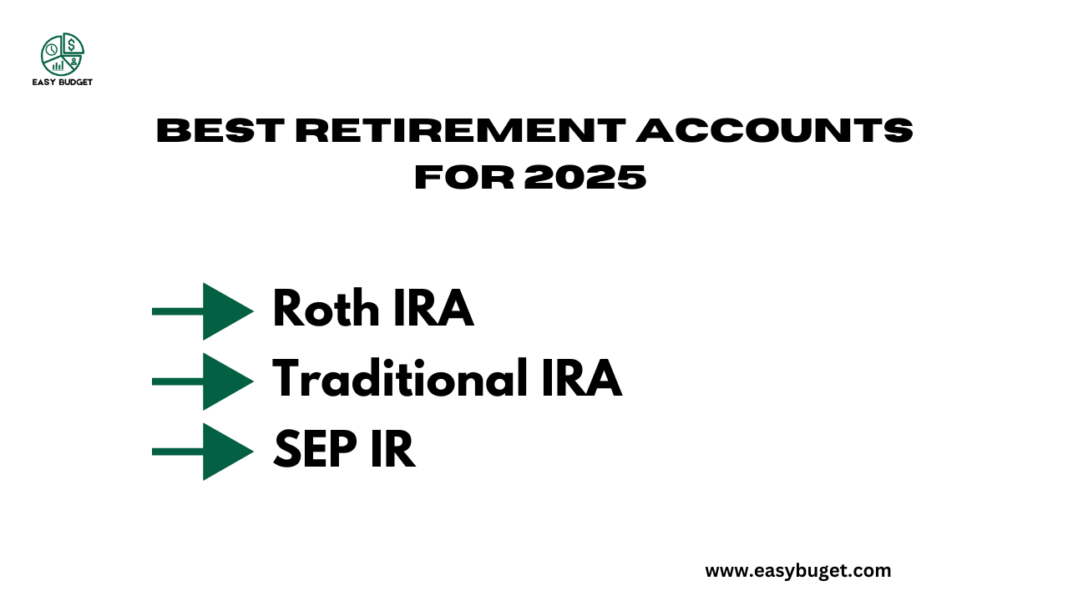Planning for retirement is one of the most important financial decisions you can make. Choosing the right retirement account is the key to build a secure future. As we move into 2025, it is important to understand the different retirement accounts available for you and how each tool can impact your long-term financial strategy. In this blog post, we’ll compare three of the best retirement accounts: Roth IRA, Traditional IRA, and SEP IRA—so you can make an informed decision about which one suits your needs best.
Understanding the Basics: Roth IRA, Traditional IRA, and SEP IRA
Before diving into the specifics, let’s quickly define what these accounts are:
Roth IRA
A retirement account where you can contribute money after paying taxes, and your investments grow tax-free. Withdrawals in retirement are also tax-free, provided you meet certain conditions.
Traditional IRA
A retirement account where contributions are typically made with pre-tax dollars, which means they may reduce your taxable income in the year you contribute. However, withdrawals in retirement are taxed as ordinary income.
SEP IRA
A Simplified Employee Pension (SEP) IRA is a retirement account primarily designed for self-employed individuals or small business owners. Contributions are made pre-tax, and the account grows tax-deferred until retirement.
Roth IRA: Tax-Free Growth and Withdrawals
The Roth IRA is often considered the “gold standard” for retirement accounts, especially for younger investors or those expecting to be in a higher tax bracket in retirement.
Here is why:
Advantages of Roth IRA
- Tax-Free Withdrawals: Since you contribute after-tax money, all qualified withdrawals in retirement are completely tax-free, including any investment gains.
- No Required Minimum Distributions (RMDs): With a Roth IRA, you are not required to take RMDs during your lifetime, which means you can leave your savings to grow as long as you like.
- Flexible Withdrawals: You can withdraw your contributions (but not your earnings) at any time without penalty or taxes, which gives you a lot of flexibility.
- Ideal for Younger Investors: If you’re starting to invest in your 20s or 30s, a Roth IRA allows you to take advantage of years of tax-free growth, potentially creating a substantial nest egg by the time you retire.
Disadvantages of Roth IRA
- Income Limits: There are income limits to contribute to a Roth IRA, and high earners may not be eligible. In 2025, the income phase-out range for Roth IRA contributions is $138,000 to $153,000 for single filers and $218,000 to $228,000 for married couples filing jointly.
- No Immediate Tax Deduction: Unlike a Traditional IRA, you don’t get a tax deduction for contributing to a Roth IRA. This may be a downside if you’re looking for an immediate tax break.
Traditional IRA: Upfront Tax Savings
The Traditional IRA is the more “traditional” option for many people. If you want to reduce your taxable income in the year you contribute, a Traditional IRA might be the better choice.
Advantages of Traditional IRA
- Immediate Tax Deduction: Contributions to a Traditional IRA are tax-deductible in the year they are made, which can provide an immediate tax break.
- Tax-Deferred Growth: Your investments grow tax-deferred until you withdraw them in retirement, meaning you don’t pay taxes on any gains until you start taking distributions.
- No Income Limits for Contributions: Unlike the Roth IRA, there are no income limits for contributing to a Traditional IRA, though your ability to deduct contributions may be affected by your income and whether you or your spouse is covered by a workplace retirement plan.
- Widely Accessible: Almost anyone can open and contribute to a Traditional IRA, making it a great option for individuals who don’t have access to a 401(k) or other employer-sponsored retirement plans.
Advantages of Traditional IRA
- Taxes in Retirement: When you withdraw funds from a Traditional IRA in retirement, you’ll have to pay taxes on the money you take out. This can be a disadvantage if you’re in a higher tax bracket in retirement than you were during your working years.
- Required Minimum Distributions (RMDs): Starting at age 73, you must begin taking RMDs from your Traditional IRA, whether you need the money or not. This can force you to take out more than you planned, potentially increasing your tax burden in retirement.
SEP IRA: A Powerful Tool for Small Business Owners and Self-Employed Individuals
If you are self-employed or own a small business, a SEP IRA might be the best option for you. The SEP IRA is designed to allow business owners to make large contributions to their retirement accounts, which can be especially beneficial if you are looking to maximize your retirement savings.
Advantages of SEP IRA
- Higher Contribution Limits: One of the biggest advantages of a SEP IRA is the contribution limit. In 2025, you can contribute up to 25% of your income (up to $66,000). This is significantly higher than the contribution limits for Roth or Traditional IRAs, making it ideal for small business owners or freelancers with higher incomes.
- Tax-Deductible Contributions: Like the Traditional IRA, contributions to a SEP IRA are tax-deductible, reducing your taxable income for the year.
- Easy to Set Up and Manage: A SEP IRA is easy to set up and doesn’t require a lot of administrative work, making it a great option for small businesses.
Advantages of SEP IRA
- Only Employer Contributions: Unlike a Traditional or Roth IRA, you can’t make personal contributions to a SEP IRA. Only the employer (you, if you’re self-employed) can contribute to the account, and contributions are based on a percentage of your income.
- No Catch-Up Contributions: Unlike 401(k)s or Traditional IRAs, SEP IRAs don’t allow for catch-up contributions for individuals over 50, which may limit your ability to save extra in your later years.
- Mandatory Contributions: If you have employees, you must contribute the same percentage to their SEP IRA accounts as you contribute to your own, which can add to your business costs.
Which Account Is Best for You?
The best retirement account for you depends on several factors, including your income, employment status, and long-term financial goals. Here’s a quick breakdown:
- Roth IRA: Best if you want tax-free withdrawals in retirement and can meet the income limits. Ideal for young investors or those expecting to be in a higher tax bracket in retirement.
- Traditional IRA: Best if you want to reduce your taxable income now and expect to be in a lower tax bracket in retirement. It’s a great option for most individuals who don’t have a 401(k) or other employer-sponsored plan.
- SEP IRA: Best for self-employed individuals or small business owners who want to contribute large amounts to their retirement accounts. The higher contribution limits make this a powerful tool for retirement savings.
Here is a table summarizing the key differences between the Roth IRA, Traditional IRA, and SEP IRA:
| Feature | Roth IRA | Traditional IRA | SEP IRA |
|---|---|---|---|
| Eligibility | No age limit, but income limits apply for contributions. | Available to anyone under 70½ with earned income. | Self-employed individuals or small business owners. |
| Contribution Limits (2025) | $6,500 ($7,500 if 50 or older) | $6,500 ($7,500 if 50 or older) | Up to 25% of income or $66,000 (whichever is less). |
| Tax Treatment | Contributions are made with after-tax dollars; withdrawals are tax-free. | Contributions are tax-deductible; withdrawals are taxed as ordinary income. | Contributions are tax-deductible; withdrawals are taxed as ordinary income. |
| Growth | Tax-free growth | Tax-deferred growth | Tax-deferred growth |
| Withdrawals | Tax-free after age 59½, provided the account is open for at least 5 years. | Taxed as ordinary income at retirement. | Taxed as ordinary income at retirement. |
| Required Minimum Distributions (RMDs) | No RMDs during the account holder’s lifetime. | RMDs begin at age 73. | RMDs begin at age 73 (if applicable). |
| Catch-Up Contributions | Yes, $1,000 if 50 or older | Yes, $1,000 if 50 or older | No catch-up contributions allowed. |
| Income Limits for Contributions | Yes, phased out for high earners ($138,000 – $153,000 for single filers; $218,000 – $228,000 for married couples). | No income limits for contributions, but deductions may be limited based on income and participation in a workplace retirement plan. | No income limits for contributions. |
| Flexibility in Withdrawals | Contributions can be withdrawn at any time tax-free. | Withdrawals before age 59½ may incur penalties. | Withdrawals before age 59½ may incur penalties. |
| Ideal For | Younger individuals, those expecting higher taxes in retirement. | Individuals looking for tax relief in the present. | Self-employed individuals and small business owners looking to contribute large amounts. |
| Administrative Fees | Low fees, typically minimal paperwork. | Low fees, minimal paperwork. | Low fees, easy setup with minimal maintenance. |
This table provides a clear, side-by-side comparison of the three retirement accounts, making it easier to understand the key differences between them.
Conclusion
When choosing a retirement account, it’s important to consider your financial situation and retirement goals. The Roth IRA, Traditional IRA, and SEP IRA each have unique benefits that can help you build wealth for retirement. By understanding the pros and cons of each account, you can make the best decision for your future and set yourself up for a comfortable, secure retirement.
If you’re unsure which option is right for you, consulting with a financial advisor can help you develop a strategy that aligns with your long-term goals. Happy saving!
Please subscribe Easy Budget to stay updated about our latest blogs!















[…] is better for retirement accounts?Both are excellent, but the S&P 500’s stability may be preferable for conservative retirement […]
[…] level: Kept in a low risk account like a high-yield savings account or money market […]
[…] Roth IRA: Contributions are made with after-tax dollars, but withdrawals in retirement are tax-free. […]
[…] can save for retirement through various accounts, such as employer-sponsored 401(k)s, individual retirement accounts (IRAs), and other savings […]